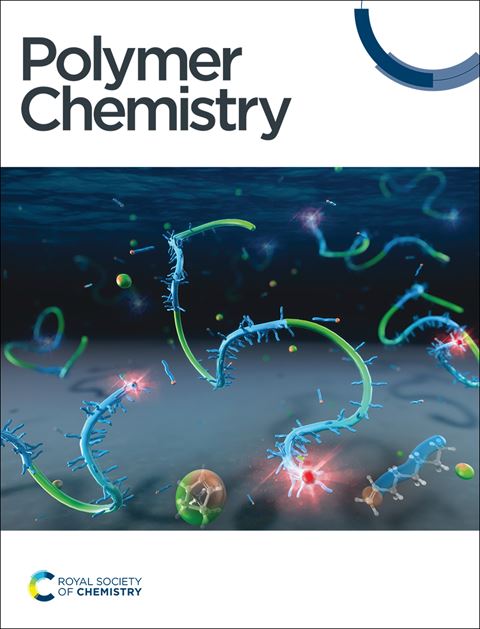Monodisperse amphiphilic double-crystalline block oligomers composed of linear alkyl chains and poly(vinyl alcohol) segments prepared by aldol-group transfer polymerization and recycling size-exclusion chromatography separation†
IF 3.9
2区 化学
Q2 POLYMER SCIENCE
引用次数: 0
Abstract
As a model of block copolymers of ethylene and vinyl alcohol, monodisperse amphiphilic double crystalline diblock oligomers composed of linear alkyl chains and poly(vinyl alcohol) segments were prepared using aldol-group transfer polymerization (aldol-GTP) and recycling size-exclusion chromatography (SEC) separation. The aldol-GTP of tert-butyldimethylsilyl vinyl ether (TBSVE) was conducted using octadecyl aldehyde as an initiator and ZnBr2 as a catalyst for the synthesis of oligo(TBSVE) with controlled molecular weights and a C16 alkyl chain and an aldehyde group at the α- and ω-chain ends, respectively. The obtained oligomers were separated into monodisperse unimers, dimers, trimers, tetramers, and pentamers via preparative recycling SEC. Reduction of the terminal aldehyde group followed by deprotection of the silyl groups resulted in monodisperse amphiphilic oligomers composed of C16 alkyl chains and poly(vinyl alcohol) (PVA) units. The effects of the number of PVA units on the thermal properties were characterized using differential scanning calorimetry. Furthermore, the morphology of the discrete block oligomer was examined by optical microscopy, atomic force microscopy, and small- and wide-angle X-ray scattering. Owing to the high incompatibility between the hydrophobic and hydrophilic blocks, self-assembly was observed despite the very low molar weights of the polymers. Based on our results, we propose that a double-crystalline lamellar structure is formed and consists of alternating hydrophobic (alkyl chains) and hydrophilic (PVA segments) domains (with a period of 6.8 nm), showing a distinct crystallization/melting process.
由线性烷基链和聚乙烯醇段组成的单分散两亲性双晶嵌段低聚物,采用醛基团转移聚合和循环排粒径层析分离制备
作为乙烯和乙烯醇嵌段共聚物的模型,利用醛醇基团转移聚合(醛醇-GTP)和循环尺寸排阻色谱(SEC)分离制备了由线性烷基链和聚乙烯醇段组成的单分散两亲双晶二嵌段低聚物。以十八烷基醛为引发剂,ZnBr2 为催化剂,对叔丁基二甲基硅基乙烯基醚(TBSVE)进行了醛醇-GTP 反应,合成了分子量可控的低聚物(TBSVE),其 和 链端分别含有 C16 烷基链和醛基。获得的低聚物通过制备性循环 SEC 分离成单分散的单聚物、二聚物、三聚物、四聚物和五聚物。还原末端醛基后再对硅烷基团进行脱保护处理,可得到由 C16 烷基链和聚乙烯醇(PVA)单元组成的单分散两亲低聚物。采用差示扫描量热法研究了 PVA 单元数量对热性能的影响。此外,还利用光学显微镜、原子力显微镜以及小角和广角 X 射线散射对离散块状低聚物的形态进行了研究。由于疏水性和亲水性嵌段之间的高度不相容性,尽管聚合物的摩尔重量很低,但仍能观察到自组装现象。根据我们的研究结果,我们认为形成了一种双晶层状结构,由交替的疏水(烷基链)和亲水(PVA 段)域(周期为 6.8 nm)组成,显示了一个独特的结晶/熔化过程。
本文章由计算机程序翻译,如有差异,请以英文原文为准。
求助全文
约1分钟内获得全文
求助全文
来源期刊

Polymer Chemistry
POLYMER SCIENCE-
CiteScore
8.60
自引率
8.70%
发文量
535
审稿时长
1.7 months
期刊介绍:
Polymer Chemistry welcomes submissions in all areas of polymer science that have a strong focus on macromolecular chemistry. Manuscripts may cover a broad range of fields, yet no direct application focus is required.
 求助内容:
求助内容: 应助结果提醒方式:
应助结果提醒方式:


